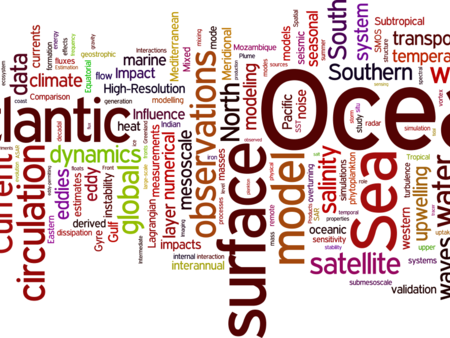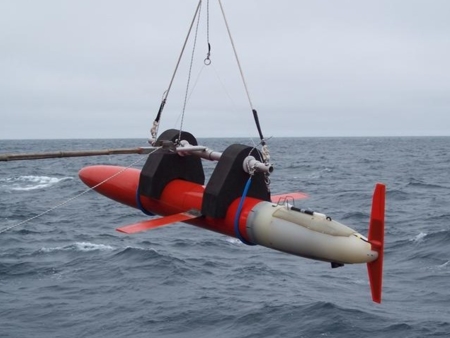OVIDE - Observatoire de la variabilité interannuelle et décennale en Atlantique Nord
The Ovide project aims at documenting and understanding the variability of the circulation and water mass properties in the northern North Atlantic within the context of global change. The North Atlantic subpolar gyre is a key region for the European climate. The winter heat release from the ocean to the atmosphere contributes to temperate Western Europe winters (Stommel 1957) and the northward heat transport associated to the meridional overturning circulation (Ganachaud and Wunsch 2000) is characteristic of the present interglacial climate. The North Atlantic Current carries the warm subtropical waters northward. They are progressively cooled and transformed into subpolar waters and eventually reach the formation regions of the North Atlantic Deep Waters in the Labrador and Greenland Seas.
The low-frequency atmospheric variability in the North Atlantic is characterized by the North Atlantic Oscillation (NAO). The NAO index, which is defined as the difference in sea level pressure between Azores and Iceland, exhibits a rich variability spectrum (Visbeck, 2003). At quasi-decadal time scales, the ocean circulation (Hakkinen and Rhines 2004), the deep water formation and the water mass property variability show convincing correlations with NAO. However, because the variability is at low-frequency, long time series are needed for the documentation of the variability and further understanding.
Since 2002, the Ovide project contributes to the observation of both the circulation and the water mass properties along a section from Greenland to Portugal. Additional measurements are also conducted in the Irminger Sea and Iceland Sea (current meter mooring array, Argo float deployments, and surface measurements on voluntary observing ships). We carry out cruises and modelling studies to characterise the interannual variability of:
- The meridional overturning circulation between Greenland and Portugal, the associated main current transports and heat and fresh water transports.
- The water mass properties.
- The inventories and transports of geochemical tracers from natural or anthropogenic origin. The North Atlantic Ocean is a sink for anthropogenic gazes as carbon dioxide (Sabine et al. 2004) or Chlorofluorocarbons (Rhein et al. 2002) and it is necessary to understand how those anthropogenic tracers are transported in order to evaluate the fate of the ocean sink.
We seek relationships between the observed ocean variability and that of the atmospheric forcing. This is also done using diagnostic and prognostic models.
The Ovide project contributes to CLIVAR, IOCCP and Go-Ship international programmes.
- Présentation du projet
L'objectif du projet Ovide est de contribuer à documenter et comprendre l'origine de la variabilité de la circulation et des masses d'eau au nord de l'Atlantique Nord dans le contexte du changement climatique. Le gyre subpolaire de l'Atlantique Nord est une région importante pour le climat de par les transferts de chaleur qui y sont associés et qui participent à tempérer le climat européen (Stommel, 1979). C'est aussi le lieu de transformation progressive en eau subpolaire de l'eau d'origine subtropicale qui est transportée par la dérive Nord Atlantique et qui alimente les zones de formation de l'eau profonde Nord Atlantique en mers du Labrador et du Groenland.
La variabilité basse fréquence de l'atmosphère en Atlantique Nord est caractérisée par l'Oscillation Nord Atlantique (NAO). L'indice NAO, défini comme la différence de pression atmosphérique de surface entre les Açores et l'Islande, présente un spectre de variabilité très riche (Visbeck 2003). À l'échelle de temps quasi-décennale, la variabilité de la circulation océanique, de la formation des eaux modales, des propriétés des masses d'eau montrent une certaine corrélation avec celle de l'indice NAO. Parce que la variabilité est de basse fréquence, des séries temporelles longues sont nécessaire pour la documenter et en comprendre les mécanismes.
Ovide contribue depuis 2002 à l'observation des éléments de circulation et des propriétés des masses d'eau le long d'une section entre le Groenland et le Portugal. Des mesures complémentaires sont effectuées en Mer d'Irminger et Mer d'Islande (mouillages de courantométrie, contribution au programme Argo et mesures de surface sur des navires d'opportunité). Nous menons des campagnes en mer et des études en modélisation pour caractériser la variabilité de:
- l'amplitude de la circulation thermohaline entre le Groenland et le Portugal ainsi que les variations associées des transports des principaux courants et des transports méridiens de chaleur et d'eau douce.
- des caractéristiques des masses d'eaux.
- des inventaires et des transports de traceurs géochimiques d'origine naturelle et anthropique. L'océan contribue à stocker les gaz à effet de serre en particulier le carbone d'origine anthropique (Sabine, 2004) et les CFCs. Il est nécessaire de comprendre comment ces gaz sont transportés par l'océan car cela conditionne à moyen terme la capacité de stockage océanique.
Des relations entre la variabilité océanique observée et la variabilité des forçages sont recherchées. Ce problème est aussi abordé par l'utilisation de modèles pronostiques et diagnostiques.
Le projet Ovide est une contribution aux programmes internationaux CLIVAR, IOCCP, Go-Ship.







